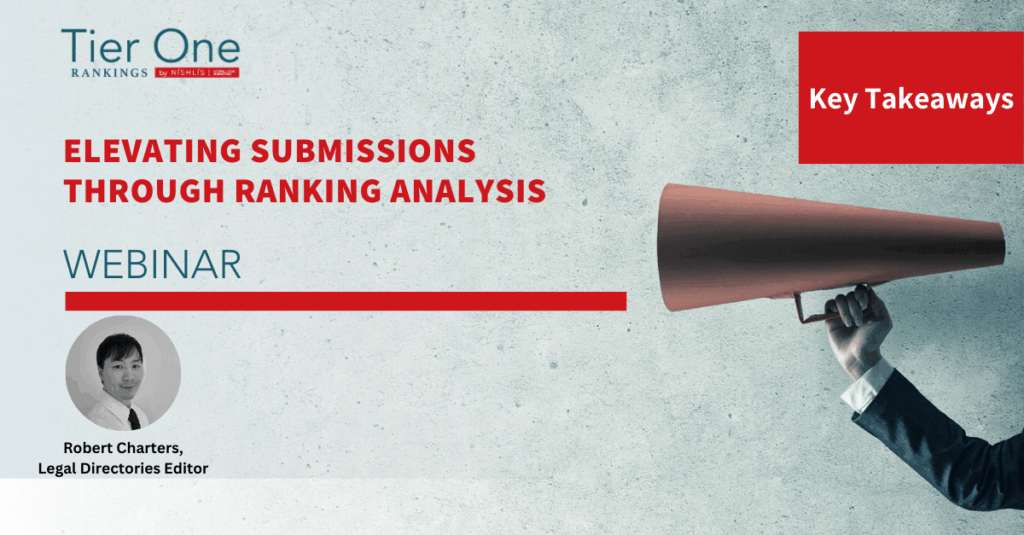On 19th November 2025, Tier One Rankings held a webinar on preparing for the submission cycle, presented by our Legal Directories Editor, Robert Charters. Specifically, the webinar looked at conducting an analysis in order to help set submission strategy. In case you couldn’t make it – or if you just wanted a written record of what was discussed – here are the key takeaways from Robert’s webinar:
1. An analysis is worth doing in order to set strategy and correct any inefficiencies that might have arisen previously.
By understanding what the team is lacking in the eyes of Research, and by seeing what higher ranked firms are doing well, we can try and tailor the next submission to tick the boxes that Research wants.
2. Paid-for tools like Chambers Insight of Legal 500’s Insight Essentials are simple ways to get this analysis.
The directories do all the hard work of compiling the insights and then present actionable tips for improvement. There is no guessing about what Research wants. However, these are expensive products.
If you are interested in buying but the budget only stretches so far, you might consider the following strategies:
- Buy a report for your chosen practice area(s) every two years – the insights you learn can likely still be applied the following year
- Only buy Chambers one year and then only buy Legal 500 the next – the insights you learn can likely still be applied the following year.
- Focus on buying reports where the lawyers are particularly unhappy with their ranking – the additional insight could be a difference maker.
- Focus on buying reports for areas in which the team has maintained the same ranking for 3+ years – the directories rarely promote in consecutive years. The first year after promotion will usually be about consolidating the new ranking, which can be done by doing similar things to the previous year; a paid-for report is not likely necessary.
3. A free analysis can be conducted by reading through and noting trends in the directories’ editorial and practice area definitions.
By seeing what work and clients the firms in the tier above are being praised for, we can gain insight into what plays well with Research.
It is best to do this analysis for the firms in the tier above (rather than several tiers higher) because promotions are typically one tier at a time, so it makes more sense to look at trends in the band you’re most likely to enter.
A similar analysis can be carried out on the practice area definitions, to ensure the submission is only including work that Research wants to see. This should make it easier for the Researcher to assess the quality of work highlights being put forward.
It is important that any material used for a free analysis comes directly from the directories, as this comes directly from Research and should accurately reflect what Research wants to see.
4. AI tools can be used
It is important to be aware of your company’s AI-use policy and the AI’s own data-privacy policy, but if you have permission to use AI on company data, it can be a useful tool. Potential use cases include:
- Analysing the submission to see if the content covers the trends identified in your analysis.
- Tackling the matter descriptions, to make them easily digestible to a non-expert Researcher who might not have much time to read a long description.
- Handling the lawyer bios, because Research only checks them briefly (and usually for editorial purposes), so it might be better to let AI handle this and have the lawyers focus more time on the work highlights.
5. Acting on an analysis can strengthen ranking or promotion prospects
An analysis of competitors allows you to draw comparisons with them that are, importantly, backed up by facts set out by the directories themselves. If a higher ranked firm is praised in editorial for handling a $1 billion transaction, and you have multiple ten-figure transactions of your own, it is easier to draw an argument like: “Research, you, praise this billion-dollar transaction for this firm, we’re doing the same sort of work, so perhaps we deserve a comparable ranking.”
In addition, by acting on an analysis, it is possible to show progression, which can in turn lead to positive impressions and upwards momentum. For example, if the firm has been hampered by a lack of IP disputes in the IP section and then shows it is now doing IP disputes and IP transactions, this can be presented as growth and a strengthening practice.
6. The best time to do an analysis is between the next guide launch and the relevant submission deadline.
This is because the latest insights (from the paid products and in terms of editorial) won’t be released until guide launch, so waiting allows you to work with the most up-to-date information.
However, it is also possible to do an analysis shortly after submitting – this can be crucial if the time between guide launch and submission deadline is very tight. The information might not be the most up to date but will still be relevant and can provide extra datapoints about what Research likes.
If you have any questions, our team is here to help!

